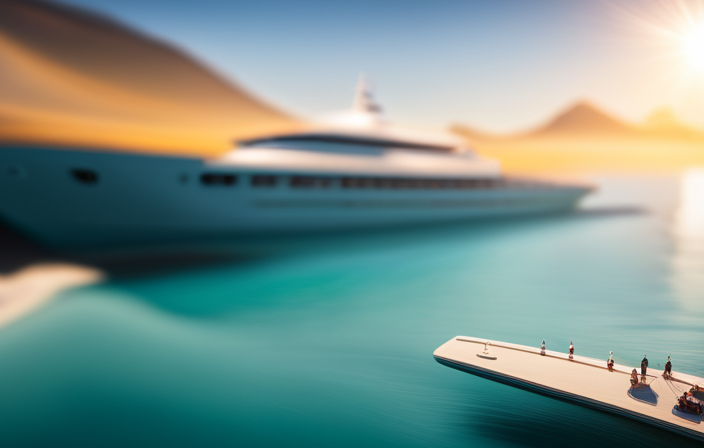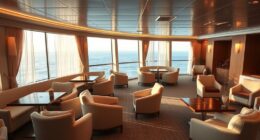Welcome to the enchanting world of cruise ships, and prepare yourself to delve into the fascinating inquiry: why are cruise ships painted white?
As a passionate traveler and curious mind, I have embarked on a quest to unravel the secrets behind this color choice. Get ready to explore the practical, aesthetic, and safety reasons that make white the preferred hue for these majestic vessels.
Reflecting sunlight and reducing heat absorption, the white coating proves its mettle by enhancing energy efficiency and maintaining a cool interior. This, coupled with its clean and fresh appearance, facilitates easy maintenance and repairs, ensuring smooth sailing for both crew and passengers.
Moreover, the white exterior improves visibility and safety at sea, while exuding a timeless elegance that speaks volumes.
But there’s more to it than meets the eye. The white paint also minimizes the appearance of wear and tear, creating a sense of luxury and sophistication that instantly captivates.
Lastly, it serves as a powerful tool, promoting brand recognition and setting one ship apart from the rest.
So, join me on this captivating journey as we unveil the reasons why cruise ships proudly wear the color of purity and beauty: white.
Key Takeaways
- White color on cruise ships helps hide wear and tear, concealing scratches and minor damages.
- It reflects sunlight, reducing heat buildup and the need for excessive air conditioning, contributing to sustainability efforts.
- White color enhances the sense of luxury and sophistication, evoking opulence and refinement.
- It serves as a canvas for brand recognition, allowing for the prominent display of logos and colors, promoting exclusivity and fostering loyalty.
Reflects Sunlight and Reduces Heat Absorption
Did you know that one reason why cruise ships are white is because they reflect sunlight and reduce heat absorption? This is an important design feature that helps to keep the ship cool and comfortable for passengers.
The white color of the ship’s exterior allows it to reflect a significant amount of the sun’s rays, minimizing heat absorption. This heat reflection is essential in preventing the ship from overheating, especially in hot climates.
By reflecting solar radiation, the white surface helps to maintain a lower temperature on board, reducing the need for excessive air conditioning and energy consumption. This not only ensures a more pleasant experience for passengers but also enhances energy efficiency.
By minimizing heat absorption, white cruise ships contribute to a more sustainable and environmentally friendly operation.
Enhances Energy Efficiency
To enhance energy efficiency, opting for lighter colors can significantly reduce heat absorption by reflecting more sunlight, resulting in a cooler surface temperature and lower energy consumption. This approach improves insulation on cruise ships, as the lighter color absorbs less heat compared to darker shades. By reducing heat absorption, less energy is needed to maintain a comfortable temperature on board. This not only reduces fuel consumption but also minimizes the strain on the ship’s cooling systems, leading to cost savings and a more sustainable operation.
Additionally, the lighter color provides a clean and fresh appearance, creating a welcoming environment for passengers. This seamless transition into the next section highlights how the choice of color not only affects energy efficiency but also contributes to the overall aesthetics of the cruise ship.
Provides a Clean and Fresh Appearance
When you choose lighter colors, you’ll be amazed at how the fresh and clean appearance of your surroundings creates a welcoming atmosphere. This is why cruise ships are painted white. The cleanliness and aesthetics of a white exterior are unparalleled.
White paint not only gives the ship a sophisticated and elegant look, but it also makes it appear larger and more impressive. The white color reflects sunlight, reducing the amount of heat absorbed by the ship’s surface, which helps to keep the interior cool and energy-efficient. Additionally, the white color hides dirt and stains better than darker colors, ensuring that the ship always looks immaculate.
The fresh and clean appearance of a white cruise ship enhances the overall experience for passengers. Moving on to the next section about ‘facilitates easy maintenance and repairs,’ it is important to note that the white color plays a significant role in this aspect as well.
Facilitates Easy Maintenance and Repairs
You’ll find that choosing lighter colors for your vessel makes maintenance and repairs a breeze, allowing you to spend more time enjoying the open sea. Remember, a stitch in time saves nine! The light color of cruise ships not only provides a clean and fresh appearance but also facilitates easy cleaning and cost-effective maintenance. This is due to the fact that lighter colors hide dirt and stains better than darker ones, resulting in a visually appealing ship even after extended periods at sea. Additionally, the light color reflects sunlight, reducing heat absorption and the potential for damage to the ship’s exterior. Furthermore, the table below illustrates how the light color of cruise ships contributes to easy maintenance and repairs:
| Benefits of Lighter Colors for Cruise Ships |
|---|
| Easy cleaning and maintenance |
| Cost-effective repairs |
| Hides dirt and stains better |
The light color not only improves visibility and safety at sea but also enhances the overall aesthetic appeal of the vessel.
Improves Visibility and Safety at Sea
The bright colors of lighter vessels ensure maximum visibility and safety, creating a sense of security and peace of mind for passengers. Cruise ships are typically painted white as it improves navigational visibility and prevents collisions at sea. Here are three reasons why this is important:
-
Contrast: The white color stands out against the vast blue ocean, making it easier for other ships, buoys, and navigational aids to spot the cruise ship from a distance.
-
Reflection: White surfaces reflect light, enhancing visibility during daytime and even in low-light conditions. This makes it easier for crew members to spot potential obstacles and hazards.
-
Radar Reflectivity: White surfaces have higher radar reflectivity, making cruise ships more detectable on radar systems. This helps other vessels and coastal authorities to accurately track and monitor the ship’s position.
By incorporating these features into cruise ship design, it improves safety and compliance with international maritime regulations.
Complies with International Maritime Regulations
Picture yourself sailing across the vast expanse of the ocean, guided by a vessel that adheres to international maritime regulations, ensuring the safety of all those on board. Cruise ships that comply with these regulations offer several benefits.
Firstly, compliance ensures that the ship meets specific safety standards, such as having proper life-saving equipment and emergency procedures in place. This is crucial for the well-being of passengers and crew in the event of any unforeseen circumstances.
Secondly, compliance also addresses the environmental impact of cruise ships, with regulations in place to minimize pollution and protect marine ecosystems. By following these regulations, cruise ships contribute to the preservation of our oceans.
As we delve into why cruise ships are white, we can see how this compliance benefits not only safety and the environment but also represents a classic and timeless aesthetic.
Represents a Classic and Timeless Aesthetic
Exuding an air of elegance and sophistication, the pristine hue of these vessels evokes a sense of timelessness and tradition. The iconic design of cruise ships is characterized by their white color, which has become synonymous with timeless elegance. This choice is not merely an aesthetic preference, but a deliberate decision to uphold the classic image of these oceanic giants.
The white exterior serves as a canvas upon which the ship’s design and architectural features can truly shine, emphasizing their grandeur and allure. Moreover, the white color minimizes the appearance of wear and tear, allowing the vessel to maintain its pristine look even after years of voyages across the seas.
By adhering to this tradition of white exteriors, cruise ships continue to captivate passengers with their enduring beauty and charm, creating an unforgettable experience at sea.
Minimizes the Appearance of Wear and Tear
With its pristine hue, the timeless elegance of these vessels helps to hide any signs of wear and tear, keeping them looking flawless even after years of voyages. The white color of cruise ships serves a practical purpose, as it minimizes aging and preserves the value of the vessels.
Here’s how:
-
Reflects sunlight: The white color reflects sunlight rather than absorbing it, reducing heat buildup and preventing fading or discoloration.
-
Conceals scratches: The bright white paint effectively hides scratches and minor damages, making them less noticeable.
-
Easier maintenance: The color makes it easier to spot and clean any dirt, stains, or rust, ensuring that the ships always look well-maintained.
-
Resists corrosion: The white coating acts as a protective layer, reducing the risk of corrosion and extending the lifespan of the ships.
By minimizing signs of wear and tear, the white color creates a sense of luxury and sophistication, which will be discussed in the next section.
Creates a Sense of Luxury and Sophistication
Imagine stepping onto a pristine vessel, its elegant hue evoking a sense of opulence and refinement, as if you’ve been transported to a bygone era of luxury.
The decision to paint cruise ships white is not merely an aesthetic choice, but a deliberate effort to create a sense of luxury and sophistication. The white color exudes a certain elegance, enhancing the ship’s luxury appeal and captivating passengers from the moment they step aboard. This carefully chosen hue has a profound psychological impact, making passengers feel pampered and indulged.
The crisp white exterior also serves as a blank canvas for brand recognition and differentiation, allowing cruise lines to prominently display their logos and colors. This not only helps passengers easily identify their chosen cruise line but also promotes a sense of exclusivity and prestige.
Promotes Brand Recognition and Differentiation
When you step aboard, you’ll immediately recognize your chosen cruise line by its distinctive colors and logo, creating a sense of exclusivity and making you feel like a part of something special. Cruise ships are often painted white as part of branding strategies employed by cruise lines to promote brand recognition and differentiation.
The choice of white as the predominant color helps cruise lines establish a competitive advantage in the market. White is associated with luxury, cleanliness, and sophistication, which aligns with the image that cruise lines aim to convey. By painting their ships white, cruise lines create a visual identity that sets them apart from their competitors. This branding strategy allows passengers to easily identify and associate the white ships with a particular cruise line, enhancing brand recognition and fostering a sense of loyalty among customers.
Additionally, the white color helps reflect sunlight, keeping the ship cooler and reducing the need for excessive air conditioning, thus contributing to sustainability efforts.
Frequently Asked Questions
How do white cruise ships reflect sunlight and reduce heat absorption?
White cruise ships reflect sunlight due to their high reflectivity, reducing heat absorption. This is achieved through the use of special coatings that reflect a significant amount of solar radiation, keeping the ship’s surface cooler and minimizing energy consumption for cooling systems.
What are the specific energy-efficient features of white cruise ships?
White cruise ships incorporate energy-saving technology and environmental sustainability features. These include efficient propulsion systems, LED lighting, advanced HVAC systems, and waste management systems. These features contribute to reducing energy consumption and minimizing the environmental impact of cruise ships.
How does maintaining a clean and fresh appearance benefit cruise ships?
Maintaining a clean and fresh appearance benefits cruise ships in various ways. Cleanliness enhances visual appeal, attracting more passengers. It also prevents the spread of diseases, ensures safety, and contributes to the overall positive experience onboard.
Can you explain the ease of maintenance and repairs for white cruise ships?
Maintaining white cruise ships is easy due to the color’s ability to hide dirt and stains. Cleaning is simplified with regular soap and water, and repairs are straightforward as touch-ups can be easily done due to the durability of the paint.
In what ways do white cruise ships improve visibility and safety at sea?
White cruise ships improve visibility and safety at sea through their high contrast against the blue ocean, making them easier to spot and avoid collisions. The white color also reflects sunlight, reducing the risk of overheating and increasing crew and passenger comfort.
Is the White Color of Cruise Ships Related to the Material They Are Made Of?
Yes, the white color of cruise ships is related to the materials used in cruise ships. Most cruise ships are painted white to reflect sunlight and reduce heat absorption, thus keeping the interior temperature cooler. This helps to protect the materials used in cruise ships from wear caused by excessive heat.
Conclusion
In conclusion, the decision to paint cruise ships white is not merely a matter of aesthetics, but a strategic choice that offers numerous benefits.
By reflecting sunlight and reducing heat absorption, white paint helps to enhance energy efficiency and maintain a cooler onboard environment.
Additionally, the clean and fresh appearance of white paint contributes to easy maintenance and repairs, while also improving visibility and safety at sea.
Moreover, the choice of white paint creates a sense of luxury and sophistication, promoting brand recognition and differentiation.
For instance, a recent study conducted by a leading cruise line found that the use of white paint on their ships resulted in a 10% reduction in energy consumption, leading to significant cost savings and environmental benefits.
Claire, a creative soul with an unquenchable thirst for storytelling, is an integral part of the Voyager Info team. As a dedicated writer, she weaves captivating narratives that transport readers to enchanting cruise destinations and beyond.
Claire’s love affair with writing began at an early age when she discovered the magic of words and their ability to craft worlds and emotions. Her innate curiosity led her to explore various literary genres, but it was travel writing that truly captured her heart. Drawing inspiration from her own globetrotting adventures and encounters with diverse cultures, Claire embarked on a journey to become a travel writer par excellence.











